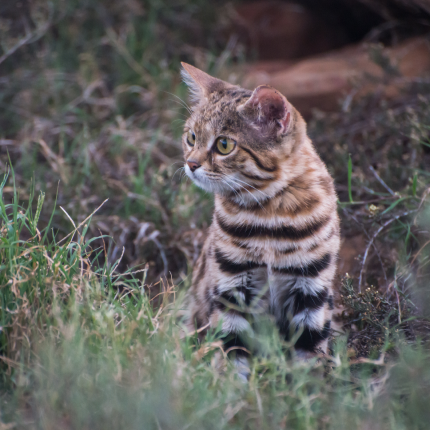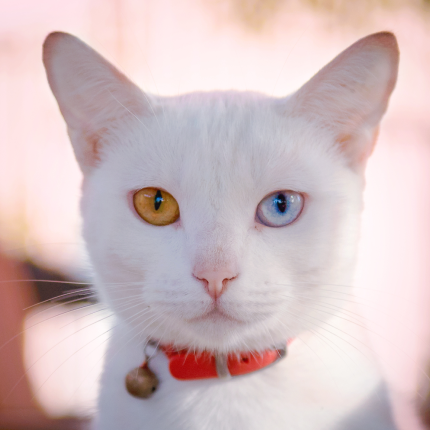The Black-Footed Cat: Nature’s Most Efficient Hunter

The Black-footed cat may resemble your average domestic feline, but it harbors a remarkable secret – it’s one of the world’s most formidable hunters. But what makes this small wildcat so dangerous?
The Black-footed cat, also known as the African black-footed cat, may appear innocuous, resembling a typical domestic tabby cat. They may look cute, but they’re, in fact, a proficient and deadly predator. Remarkably, this unassuming wildcat holds the title of the world’s smallest African wildcat and ranks as one of nature’s most efficient hunters.
Their Appearance
In terms of appearance, the Black-footed cat closely resembles its household counterparts. Standing at a mere 8 inches tall, measuring 14 to 20 inches in length, and weighing between 2.4 to 4.2 pounds, this wildcat starkly contrasts its more massive relatives, such as lions. Its coat has a light brown hue adorned with dark spots that often merge to form distinctive rings. Interestingly, the only black part of this cat is the sole of its paws, which protects them from scorching ground temperatures.
Why is the Black-footed Cat Dangerous?
The Black-footed cat’s diminutive size conceals an impressive arsenal of hunting techniques driven by its high metabolism. To satiate their constant hunger, these wildcats have honed their hunting skills to a remarkable degree. They employ three distinct hunting techniques:
- The Fast Hunt: In this technique, the Black-footed cat darts swiftly through tall grass to catch its small prey.
- The Slow Hunt: This method requires patience and stealth. The cat approaches its quarry silently and cautiously.
- The Sit-and-Wait Hunt: Similar to the slow hunt, the cat sits motionless, sometimes even closing its eyes while listening to the sounds of the night. It can remain in this position for hours, waiting for prey to come within striking range.
With these varied techniques, the Black-footed cat can successfully capture between 10 to 14 rodents or small birds in a single night, averaging an astonishing kill every 50 minutes. With a success rate of 60 percent, Black-footed cats outperform even lions, which typically succeed in hunting only about 20 to 25 percent of the time.
Their Prey
The Black-footed cat threatens creatures such as mice, birds, and rabbits. However, humans need not fear these diminutive predators, as they are extremely shy and primarily hunt at night. When driven by extreme hunger, they might occasionally attack larger prey like goats or giraffes, opting to bite the prey’s carotid artery. However, such rare instances occur only when the cat faces dire circumstances.
Their Habitat
The Black-footed cat inhabits regions of South Africa, Namibia, and Botswana. They typically make their homes in dry savannah areas, often occupying burrows previously used by other animals. Additionally, they are known to take shelter in abandoned termite mounds, earning them the moniker “ant tigers.”
A remarkable aspect of these cats is their minimal need for water, a unique adaptation to their arid habitat. However, they compensate by requiring a relatively sizeable daily food intake, approximately 250 grams of meat, to stay hydrated.
Conservation Status
Regrettably, like many other species, the African Black-footed cat faces the looming threat of extinction. In 2002, the species was added to the “IUCN Red List of Endangered Species.” Limited awareness and insufficient funding contribute to the challenges of its preservation. While adopting an African Black-footed cat is not a solution to their extinction, protecting their natural habitat remains a critical step in their conservation efforts.
The World’s Most Dangerous Cat?
The title of the world’s most dangerous cat depends on the criteria considered. Lions, tigers, leopards, and cheetahs are often associated with exceptional hunting prowess and imposing physiques. However, when evaluating success in hunting, it’s the unassuming Black-footed cat that reigns supreme. With an astounding 60 percent success rate in nightly raids and the ability to eliminate up to 14 rodents in a single night, this diminutive wildcat is indeed a remarkable and awe-inspiring hunter.

Featured Articles

The Odd-Eyed Cat (AKA Heterochromia)
Cats are already beautiful and fascinating creatures, but people are bound to take notice when they have something as captivating as two different colored eyes. Odd-eyed cats always have one blue eye paired with either a green, yellow, or brown eye. This form of heterochromia occurs in other animals, including…

Polydactyl Cats: Just More Beans to Love
Polydactyl cats have become extremely popular in recent times. As a result, more and more people are interested in learning more about this six-toed cat and want to get one of their own. If you are a cat lover intrigued by polydactyl cats, you have come to the right place….

Why Do Cats Roll Over Into Their Backs But Not Let You Touch Their Bellies?
It’s common knowledge dogs love to have their tummies rubbed when they freely lay down before you and roll onto their backs. But, if you’re also familiar with cats, you know that when they roll onto their backs with their bellies exposed, rubbing the belly will most likely result in…